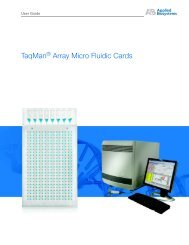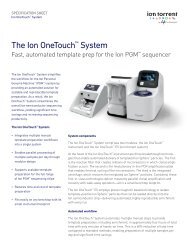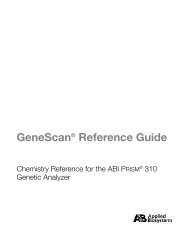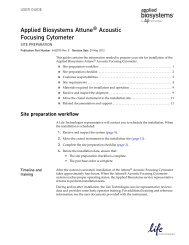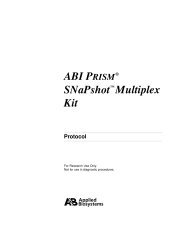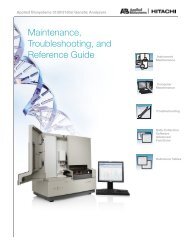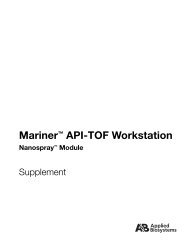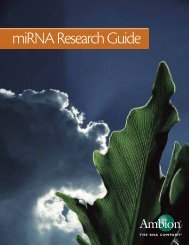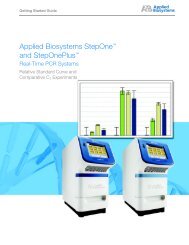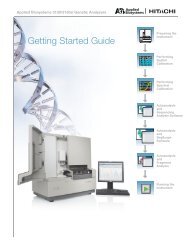Applied Biosystems SOLiD™ 4 System SETS Software User Guide ...
Applied Biosystems SOLiD™ 4 System SETS Software User Guide ...
Applied Biosystems SOLiD™ 4 System SETS Software User Guide ...
Create successful ePaper yourself
Turn your PDF publications into a flip-book with our unique Google optimized e-Paper software.
6<br />
Chapter 6 Support Multiplexing<br />
Fragment and Paired-End Multiplexing<br />
Fragment and Paired-End Multiplexing<br />
Overview of<br />
Multiplexing and<br />
Barcodes<br />
Multiplexing in general, and barcodes in particular, enable the<br />
SOLiD 4 <strong>System</strong> to target many applications, from deep<br />
sequencing of a single source to extreme parallel sequencing of a<br />
large number of samples over limited regions - sometimes on the<br />
same slide.<br />
The additional stretches of DNA sequence, known as barcodes, can<br />
be used to segregate pooled library samples during sequencing back<br />
into their original (logical) single library groupings. Barcodes –in<br />
their simplest form– allow the pooling of samples on a slide without<br />
the loss of surface area creating geographic isolations. Multiplexing<br />
occurs at both the whole slide level as well as at the geographically<br />
isolated (mask) region level.<br />
A barcode, by definition, is a tag with a known sequence that is<br />
attached to a sequencing primer on a bead during library preparation.<br />
When sequenced, it is the barcode that identifies and classifies the<br />
bead to a named sample. This barcoding, or indexing, approach<br />
allows multiplexing at the sequencing level.<br />
Following sequencing of the target DNA, additional rounds of<br />
ligation-based sequencing are performed using primer sets<br />
complimentary to the barcode. The resulting reads can then be sorted<br />
by the barcode and aligned in groups to the reference sequence.<br />
Barcodes are assigned to a library both conceptually and physically<br />
(as specific tags) as part of the library preparation. If more than one<br />
barcode is assigned to a single library during the library preparation<br />
step, the conceptual grouping is referred to as a barcode group. All<br />
barcodes in the pool will assign the underlying beads to the same<br />
original library for analysis.<br />
The SOLiD 4 <strong>System</strong> supports multiplexing for both fragment<br />
sequencing and paired-end sequencing. See “Naming convention for<br />
sequencing reads” on page 11.<br />
Note: Multiplexing is not available for mate-paired libraries.<br />
104 <strong>Applied</strong> <strong>Biosystems</strong> SOLiD 4 <strong>System</strong> <strong>SETS</strong> <strong>Software</strong> <strong>User</strong> <strong>Guide</strong>



